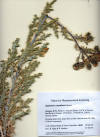|
Argemone gracilenta |
Argemone pleiacantha |
|
Argemone mexicana An alkaloid, berberine sulfate, active in B1 and WA, was reportedly found in this species by many investigators (Hartwell 1976). |
Mohave Co., AZ, vicinity of Kingman
|
|
Argemone munita ssp. rotundata Esmeralda Co., NV, 7500 ft
|
|
|
Argemone platyceras Capasso A., S. Piacente, C. Pizza, N. de Tommasi, C. Jativa and L. Sorrentino. 1997. Isoquinoline alkaloids from Argemone mexicana reduce morphine withdrawal in guinea pig isolated ileum. Planta Med. 63(4): 326–328. “The present study examined the effect of the MeOH extract, partially purified fraction (IV), and pure compounds from Argemone mexicana L. (Papaveraceae) on the morphine withdrawal in guinea pig isolated ileum. The MeOH extract, the partially purified fraction (IV), and the pure compounds isolated from A. mexicana significantly and in a concentration-dependent manner reduced the morphine withdrawal. Since the pure compounds were identified as protopine and allocryptopine, the observed effects could be related to these compounds. The results of the present study suggest that isoquinoline alkaloids may be potential agents in the treatment of drug abuse.” Chang Y. C., P. W. Hsieh, F. R. Chang, R. R. Wu, C. C. Liaw, K. H. Lee and Y. C. Wu. 2003. Two new protopines argemexicaines A and B and the anti-HIV alkaloid 6-acetonyldihydrochelerythrine from formosan Argemone mexicana. Planta Med. 69(2): 148–152. “Two new protopine-type alkaloids, argemexicaine A (1) and argemexicaine B (2), along with thirteen known alkaloids, were isolated from MeOH extracts of Formosan Argemone mexicana L. (Papaveraceae). Physical and spectral analyses, particularly IR and thermo-modulated 1D and 2D NMR, were used to determine the transannular conformations of the isolated protopine-type alkaloids. The known benzo[ c]phenanthridine (+/-)-6-acetonyldihydrochelerythrine (5) exhibited significant anti-HIV activity in H9 lymphocytes with EC50 and TI (Therapeutic Index) values of 1.77 microg/mL and 14.6, respectively.” Fernandez. J, R. Reyes, H. Ponce, M. Oropeza, M. R. Vancalsteren, C. Jankowski and M. G. Campos. 2005. Isoquercitrin from Argemone platyceras inhibits carbachol and leukotriene D4-induced contraction in guinea-pig airways. “Argemone platyceras is used in Mexico as a remedy for cough, bronchitis and pneumonia. The present study was performed to investigate the pharmacological anti-asthmatic properties of Argemone platyceras on airways and to identify its active principles. Methanol extracts of leaves and flowers, subsequent organic and aqueous extraction phases, and silica gel chromatography fractions were assayed on the carbachol-induced response, and/or on ovalbumin antigenic challenge, and on leukotriene D(4)-induced response of tracheae from sensitized and non-sensitized guinea-pigs. Methanol extracts, ethyl-acetate phase, and its fractions 6 and 7 inhibited the carbachol-induced contractile response. Isoquercitrin and rutin were the main compounds found in fractions 6 and 7 respectively. Isoquercitrin (fraction 6) abolished the response to ovalbumin, and decreased the contractile response to leukotriene D(4). Because of its effect on carbachol-induced contractile response, on the late-phase response to ovalbumin, and on leukotriene D(4)-induced contractile response, isoquercitrin might be highly useful in treatment of asthma.” Thatte U. and S. Dahanukar. 1999. The Mexican poppy poisons the Indian mustard facts and figures. J. Assoc. Physicians India. 47(3): 332–335. “Argemone seeds are mixed with mustard seeds either accidentally or purposefully, and, ingestion of this contaminated oil can lead to often fatal "epidemic dropsy". The liver, heart, kidney and lungs are the major target organs of the toxins (the alkaloids, sanguinarine and dihydrosanguinarine) and damage is mostly caused by free radical (singlet oxygen and hydroxyl radical) to the cell membranes. Treatment at present is mainly symptomatic but therapy with anti-secretory agents for glaucoma and anti-oxidants/free radical scavengers for systemic manifestations appear to be logical.” |
|




